2010 AUDI S6 engine
[x] Cancel search: enginePage 254 of 368
![AUDI S6 2010 Owners Manual Driving and environment
(I] Tip s
The consumption estimates as pub lished by ENV IRONMENTAL
PROTECTION AGENCY (EPA) and Transport Canada may not corre
spond to your actual consump AUDI S6 2010 Owners Manual Driving and environment
(I] Tip s
The consumption estimates as pub lished by ENV IRONMENTAL
PROTECTION AGENCY (EPA) and Transport Canada may not corre
spond to your actual consump](/manual-img/6/57594/w960_57594-253.png)
Driving and environment
(I] Tip s
The consumption estimates as pub lished by ENV IRONMENTAL
PROTECTION AGENCY (EPA) and Transport Canada may not corre
spond to your actual consumption on the road, which will vary
depending upon vehicle load and speed, road and weather conditions,
trip length, etc. •
Drive smoothly and keep a lookout ahead
Vehicles use the most fuel when they are accelerating .
-Avo id unnecessary accelerating and braking.
Vehicles use the most fue l when they a re accele rating. If you antici
pate what is going to happen next, you will need to brake less and,
thus, accelerate less. Let the vehicle coast whenever possible -for
example when you see that the next traffic l ight is red. •
Avoid full throttle
Driving at moderate speeds saves fuel and improves your
mileage.
- Try and keep well below your car's maximum speed .
Accelerating gently reduces fuel consumption, engine wear, and does
not disturb the environment.
Fuel consumption, exhaust emissions and engine noise increase
disproportionately at high speeds . If you drive at approx imately three
qua rters of top speed, fuel consumption will be reduced by one half.
Never drive faster than the posted speed limit and weather condi
tions permit.
a Reducing unnecessary idling
Even when your car is just idling it burns up fuel.
-
Shut the engine off when yo u are not driving the vehicle.
- Do not warm up the vehic le by letting the eng ine run at
idle.
It makes sense to shut off the engine in traffic jams, when waiting for
trains to pass at rai lroad crossings, o r at traffic lights that have long
wa its on red . Turn ing the eng ine off for just 30-40 seconds saves
more fuel than is burned starting the engine again.
It takes a long t ime for the engine to warm up fully when it is running
at idle. Howeve r, wear and noxious emissions are espec ially high
when the eng ine is wa rm ing up. So you sho uld d rive away as soon as
you start the engine and avoid running at hig h rpms while the eng ine
is still warming up.
0 Note
Do not leave engine idling unattended after starting . If warning
lights should come on to indicate improper operation, they would go
unheeded. Extended idling also produces heat, which cou ld result in
overheat ing o r othe r damage to the vehicle or other p roperty. •
Regular maintenanc_e ____________ _
A badly tuned engine unnecessarily wastes a lot of fuel .
- Have your vehicle serviced at regular intervals .
By having yo ur vehicle regularly se rviced by an Audi dealer helps to
ensure that it runs properly and economically . T he condition of your
vehicle not only a ffects its safety and ability to ho ld its va lue, it a lso
affects
fu el con sumption .
Check your o il e ach tim e you fill you r tank.
~
Page 255 of 368
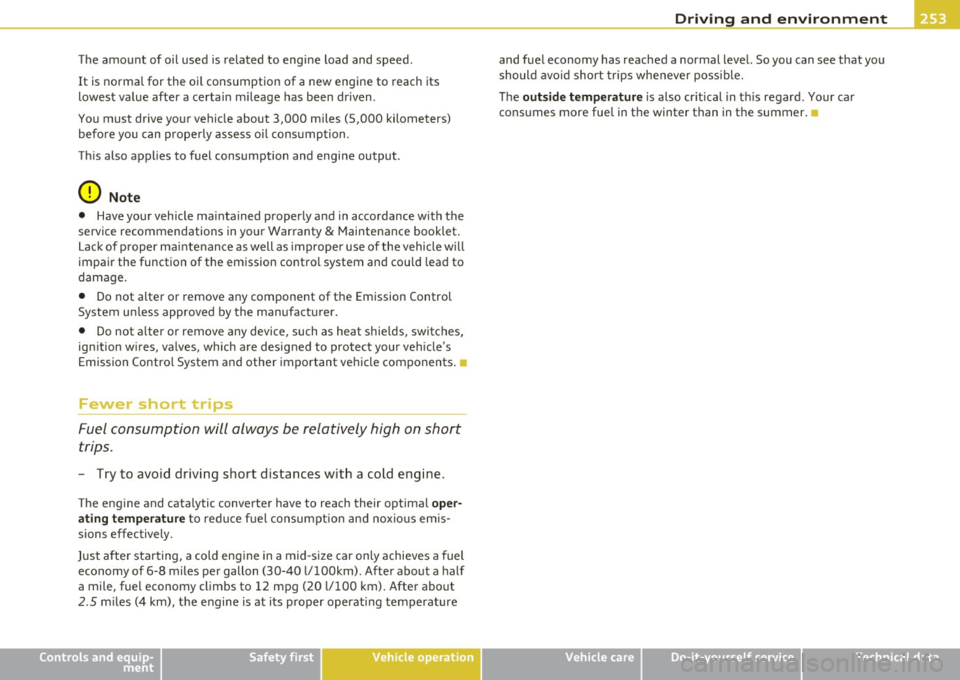
Driving and environment
------------------------------------------------'
The amount of oil used is related to engine load and speed.
It is normal for the oil consumption of a new engine to reach its
lowest value after a certain mileage has been driven .
You must drive your vehicle about 3,000 miles (5,000 kilometers)
before you can properly assess oil consumption.
This also applies to fuel consumption and engine output .
0 Note
• Have your vehicle maintained properly and in accordance with the
service recommendations in your Warranty
& Maintenance booklet.
Lack of proper maintenance as well as improper use of the vehicle w ill
impair the function of the emission control system and cou ld lead to
damage.
• Do not alter or remove any component of the Emission Control
System un less approved by the manufacturer.
• Do not a lter or remove any device, such as heat shie lds, switches,
ignition wires, valves, which are designed to protect your vehicle's Emission Contro l System and other important vehicle components. •
Fewer short trips
Fuel consumption will always be relatively high on short
trips .
-Try to avoid driving short distances with a cold engine.
The eng ine and catalytic converter have to reach thei r optima l oper
ating temperature
to reduce fuel consumption and noxio us em is
sions effectively.
Just after starting, a cold engine in a mid -size car only achieves a fuel
economy of 6-8 miles per gallon (30-40 l/l00km). After about a half
a mile, fuel economy climbs to 12 mpg (20 l/100 km). After about
2.5 miles (4 km), the engine is at its proper operating temperature
Controls and equip
ment Safety first Vehicle operation
and fuel economy has
reached a normal level. So you can see that you
should avoid short trips whenever possible.
The
outside temperature is also cr it ical in th is regard . Your car
consumes more fuel in the winter than in the summer. •
Vehicle care Do-it-yourself service Technical data
Page 258 of 368

Trailer towing
"---------------------------------------------------
Speed
T he higher the speed, the more difficult it becomes for the driver to
control the rig. Do not dr ive at the max imum permiss ible speed.
Reduce your speed even more if load, weather or wind conditions are
unfavorable -part icu larly when go ing downhill.
Reduce vehicle speed
immediately if the tra iler shows the slightest
sign of swaying.
Do not try to stop the swaying by accelerating.
Observe speed limits. In some areas, speeds for veh icles towing
trailers are lower than for regu lar vehicles.
Always apply brakes early. When driv ing dow nhill, shift in to a lower
gear to use the eng ine braking effect to slow the veh icle. Use of the
bra kes alone can cause them to overheat and fail.
Coolant temperature
Th e coolant temperature gauge~ page 8 must be observed care
fully. If the needle moves close to the upper end of the scale, reduce
speed immediately and/or turn off the air conditioner.
If the coolant temperature warning light in the instrument cluster
starts flashing
_f_ , pull off the road, stop and let the engine idle for
about two m inutes to prevent heat build-up.
& WARNING
Anyone not properly restrained in a moving vehicle is at a much
greater risk in an accident. Never let anyone ride in your car who is
not properly wearing the restraints provided by Audi.•
Trailer towing tips
Important to know
------------
Your vehicle handles differently when tow ing a trailer because of the
additiona l weight and different weight distribution. Safety, perfor- mance and economy will greatly depend on how carefully you load
your trailer and operate your rig.
Before you actually tow your trailer, practice turning, stopp ing and
backing up in an area away from traffic. Keep practicing until you have
become completely familiar with the way your vehicle-t railer comb i
nation behaves and responds.
Backing up is difficult and requires practice. Backing up with a trailer
generally requires steering action oppos ite to that when backing up
your vehicle without a trai ler.
Maintain a greater distance between your vehicle and the one in front
of you. You will need more room to stop. To compensate for the
trailer, you will need a larger than normal turning radius .
When passing, remember that you cannot accelerate as fast as you normally would because of the added load . Make sure you have
enoug h room to pass. After passing, allow plenty of room for your
trai ler before changing lanes again.
Avoid jerky sta rts, sharp tur ns or rapid lane changes.
W Tips
• Do not tow a trailer during the break-in per iod of your veh icle.
• If you tow a trai ler, your Audi may require more frequent mainte
nance due to the extra load
~ page 344. •
Parking on a slope
Do not park on a slope with a trailer. If it cannot be
avoided, do so only after doing the following:
When parking:
- Apply the foot brake.
- Have someone p lace chocks under both the vehicle and the
trailer wheels . ._
Page 260 of 368
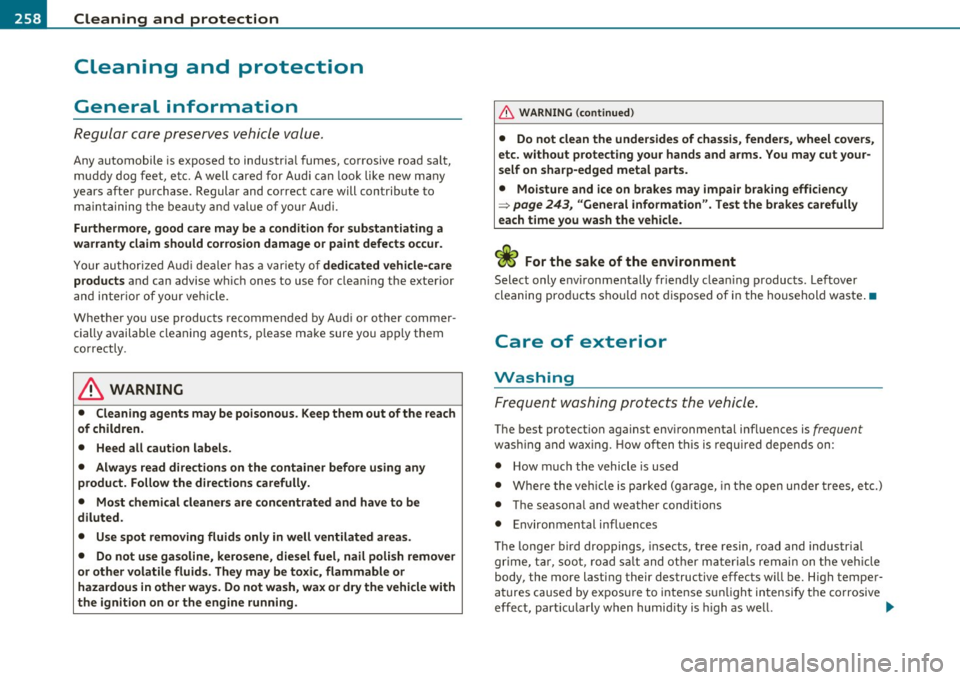
-~_C_ le_ a_n_ i_ n_ g=- a_ n_d___. p_ ro_ t_e _c_ t_ i_o _n ___________________________________________ _
Cleaning and protection
General information
Regular care preserves vehicl e val ue.
Any automobile is exposed to industria l fumes, co rrosive road salt,
m ud dy dog fee t, e tc. A well c ared for Audi can look like new many
years after p urchase . Regular and correct care will contribute to
m aint aining the bea uty and val ue of your Audi.
Furthermore, good care may be a condition for substantiating a
warranty claim should corrosion damage or paint defects occur.
Y ou r au thor ized Audi d eale r h as a var iety of dedicated vehicle-care
products
and can advise w hich ones to use for clea ning the exterior
a n d inter io r of your ve hicle.
W het her you use products recommended by Aud i or o ther comme r
cia lly availab le cleaning agents , please ma ke sure yo u appl y them
co rrectly .
& WARNING
• Cleaning agents may be poisonous . Keep them out of the reach
of children.
• Heed all caution labels .
• Always read directions on the container before using any
product. Follow the directions carefully.
• Most chemical cleaners are concentrated and have to be
diluted .
• Use spot removing fluids only in well ventilated areas.
• Do not use gasoline, kero sene , diesel fuel , nail polish remover
or other volatile fluids . They may be toxic, flammable or
hazardous in other ways. Do not wash, wax or dry the vehicle with
the ign ition on or the engine running.
& WARNING (co ntinued)
• Do not clean the under sides of chassi s, fenders , wheel covers,
etc. without protecting your hands and arms. You may cut your
self on sharp-edged metal parts.
• Moisture and ice on brakes may impair braking efficiency
~ page 243, "General information ". Test the brakes carefully
each time you wash the vehicle .
'£> For the sake of the environment
Select only envir onmenta lly fr iendly clea ning produc ts . Leftover
cleaning pro ducts sho uld not dis posed of i n the household waste .•
Care of exterior
Washing
F re qu ent w ashin g protec ts th e vehicl e.
T he best protection aga inst env ironmental influences is frequent
w ashi ng and w ax ing. How o ften t his is requ ired depen ds on:
• How m uch the vehicle is use d
• Whe re the ve hicle is parke d (gar age, in the o pen un der tr ees, e tc.)
• The seasona l and weather conditions
• E nviron mental influences
T he longer bi rd droppings , insects , tree resin, road and industria l
gr ime, t ar, soo t, road sa lt and o ther ma ter ia ls remain on the veh icle
body, the more lasti ng their destructive effects w ill be. H igh temper
atu res cause d by ex pos ure to intense s unlight int ensify the co rrosive
effect, part icu larly when humid ity is high as we ll.
~
Page 262 of 368
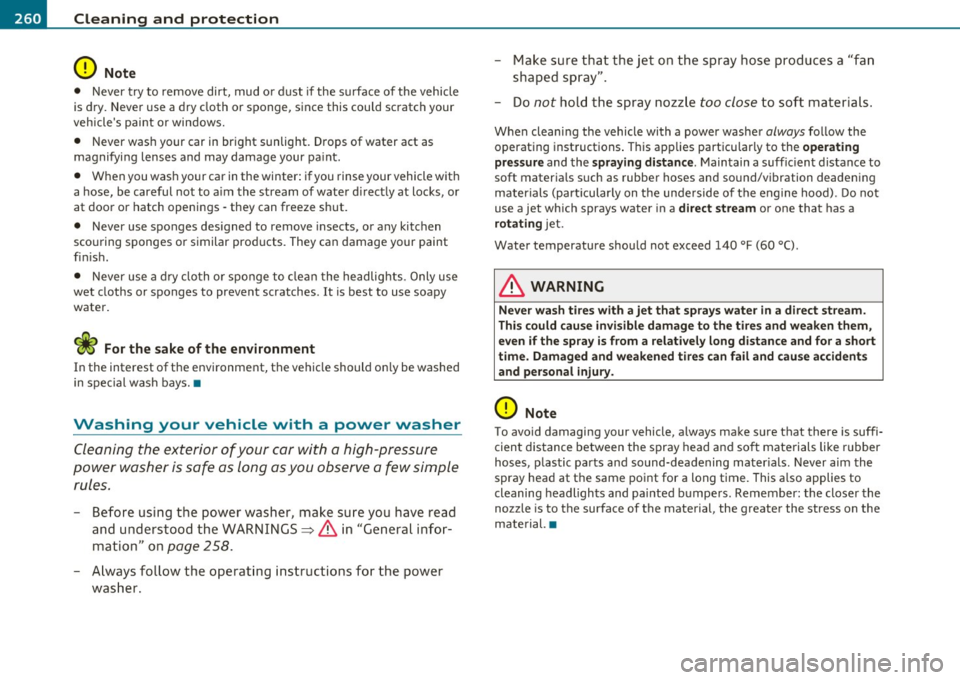
-~_C_ le_ a_n_ i_ n_ g=- a_ n_d___. p_ ro_ t_e _c_ t_ i_o _n ___________________________________________ _
0 Note
• Never try to remove dirt, mud or dust if the surface of the vehicle
is dry. Never use a dry cloth or sponge, since this could scratch your
vehicle's paint or windows.
• Never wash your car in bright sunlight . Drops of water act as
magnifying lenses and may damage your pa int.
• When you wash your car in the winter: if you rinse your vehicle with
a hose, be careful not to a im the stream of water d irectly at locks, or
at door or hatch openings -they can freeze shut.
• Never use sponges designed to remove insects, or any kitchen
scouring sponges or similar products. They can damage your paint
fin ish .
• Never use a dry cloth or sponge to clean the headlights . Only use
wet cloths or sponges to prevent scratches . It is best to use soapy
water.
For the sake of the environment
In the interest of the environment, the vehicle should on ly be washed
in special wash bays. •
Washing your vehicle with a power washer
Cleaning the exterior of your car with a high-pressure
power washer is safe as long as you observe a few simple
rules .
-Before using the power washer, make sure you have read
and unders tood the WARNINGS ~
& in "General infor
mation" on
page 258.
- Always follow the operating instructions for the power
washer. -
Make sure that the jet on the spray hose produces a "fan
shaped spray".
- Do
not hold the spray nozzle too close to soft materials.
When cleaning the vehicle with a power washer always follow the
operating instructions. This applies particularly to the
operating
pressure
and the spraying distance. Maintain a sufficient distance to
soft materials such as rubber hoses and sound/vibration deadening
materials (particularly on the underside of the engine hood). Do not
use a jet which sprays water in a
direct stream or one that has a
rotating jet.
Water temperature should not exceed 140
°F (60 °() .
& WARNING
Never wash tires with a jet that sprays water in a direct stream.
This could cause invisible damage to the tires and weaken them,
even if the spray is from a relatively long distance and for a short
time. Damaged and weakened tires can fail and cause accidents
and personal injury .
0 Note
To avoid damaging your vehicle, always make sure that there is suffi
cient distance between the spray head and soft materials like rubber
hoses , plastic parts and sound-deadening mater ials. Never aim the
spray head at the same point for a long time. This a lso applies to
cleaning headlights and painted bumpers. Remember: the closer the
nozzle is to the surface of the material, the greater the stress on the
material. •
Page 271 of 368
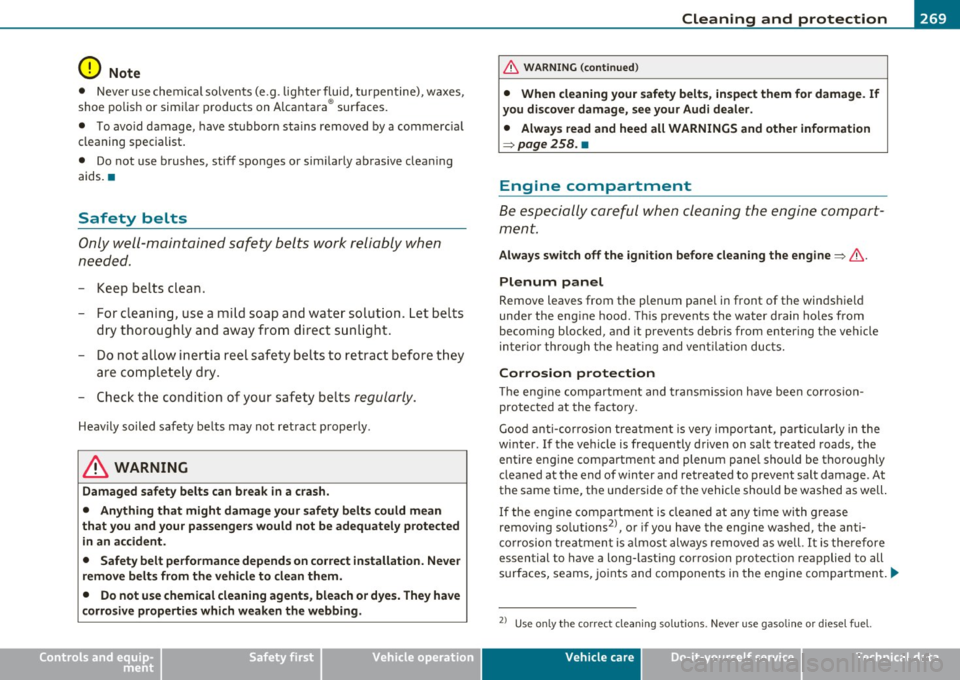
____________________________________________ C_l_e _a_ n_ i n--= g=--- a_n_ d----' p,__ r_o _t_ e_ c_ t_ i _o_ n __ _
0 Note
• N ev er use che mical s olvents (e.g. lig hte r fl uid , turpen tine), waxe s,
sho e polish or sim ila r pr oducts on A lcantara ® surfaces.
• T o avo id damage, have s tubbor n sta ins removed by a co mmerc ia l
cleaning s pecialist .
• Do not use brushes, stiff spo nges or sim ilarly ab rasive cl ea ni ng
aids. •
Safety belts
Only well- maintain ed safe ty b elts wo rk re liably when
n ee ded.
- Kee p belts cle an.
- F or clea nin g, use a mil d soap and w ate r solution. Let belts
dry thor oug hly and aw ay fro m direct s unlig ht.
- D o not a llow i nertia re el sa fety b elt s t o re trac t bef ore the y
are c ompl ete ly dry .
- Che ck th e condi tio n of you r sa fety belts
regu larly.
H eav ily so iled safe ty be lts may not ret rac t proper ly.
& WARNING
Damaged safety belts can break in a crash.
• Anything that might damage your safety belts could mean
that you and your passengers would not be adequately protected
in an accident.
• Safety belt performance depends on correct installation. Never
remove belts from the vehicle to clean them .
• Do not use chemical cleaning agents , bleach or dyes. They have
corrosive properties which weaken the webbing.
Safety first
& WARNING (co ntinued )
• When cleaning your safety belts , inspect them for damage . If
you discover damage, see your Audi dealer .
• Always read and heed all WARNINGS and other information
~page 258. •
Engine compartment
Be es pec ially care ful w hen clean ing th e engine co mp art
m en t.
Always switch off the ign ition before cleaning the engine~,&. .
Plenum panel
Remove leaves from the plenum pane l in front of the win dshi eld
under the eng ine hoo d. Thi s preven ts the wa ter d rain holes fro m
becoming blocked , and it prevents debris from enter ing t he veh icle
in ter ior thro ugh t he heat ing a nd ve ntilation ducts.
Corrosion protection
The e ng in e co mp artm ent a nd trans missio n have bee n co rros io n
protected at the facto ry .
G ood ant i- corro sion t rea tmen t is very i mporta nt, pa rt icul arly in t he
wi nte r. If the ve hicle is freq uently d riven on sa lt treated roads, the
entire eng ine compartment and plenum pane l sho uld be tho rough ly
clea ned at the end of winter and retreated to preve nt salt damage. At
the same time, t he un derside of the vehi cle should be washed as well.
If the eng ine co mpartme nt is clean ed at any t ime wi th gre ase
remov ing so lutions
2
), or if you have the engine was hed, the anti
cor rosion treat men t is almo st alw ays rem oved as well.
It is the refore
essential to have a long-last ing corrosion protection reapplied to all
s u rfaces, seams, jo ints and com ponents in the engine compartmen t.~
2> Us e on ly the co rrect clean ing so lut ions . Neve r use gaso line or diese l fue l.
Vehicle care Technical data
Page 272 of 368
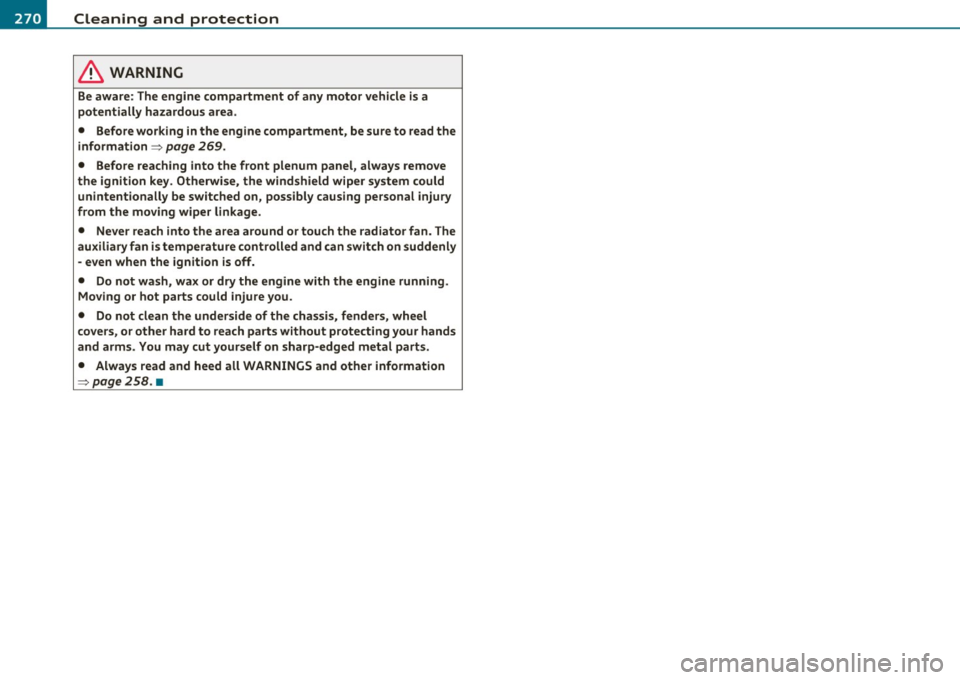
-~_C_ le_ a_n_ i_ n_ g=- a_ n_d___. p_ ro_ t_e _c_ t_ i_o _n ___________________________________________ _
in. WARNING
Be aware: The engine compartment of any motor vehicle is a
potentially hazardous area.
• Before working in the engine compartment, be sure to read the information =>
page 269.
• Before reaching into the front plenum panel, always remove
the ignition key. Otherwise, the windshield wiper system could
unintentionally be switched on, possibly causing personal injury
from the moving wiper linkage.
• Never reach into the area around or touch the radiator fan. The
auxiliary fan is temperature controlled and can switch on suddenly
- even when the ignition is off.
• Do not wash, wax or dry the engine with the engine running.
Moving or hot parts could injure you.
• Do not clean the underside of the chassis, fenders, wheel
covers, or other hard to reach parts without protecting your hands
and arms. You may cut yourself on sharp-edged metal parts.
• Always read and heed all WARNINGS and other information
=:> page 258. •
Page 273 of 368
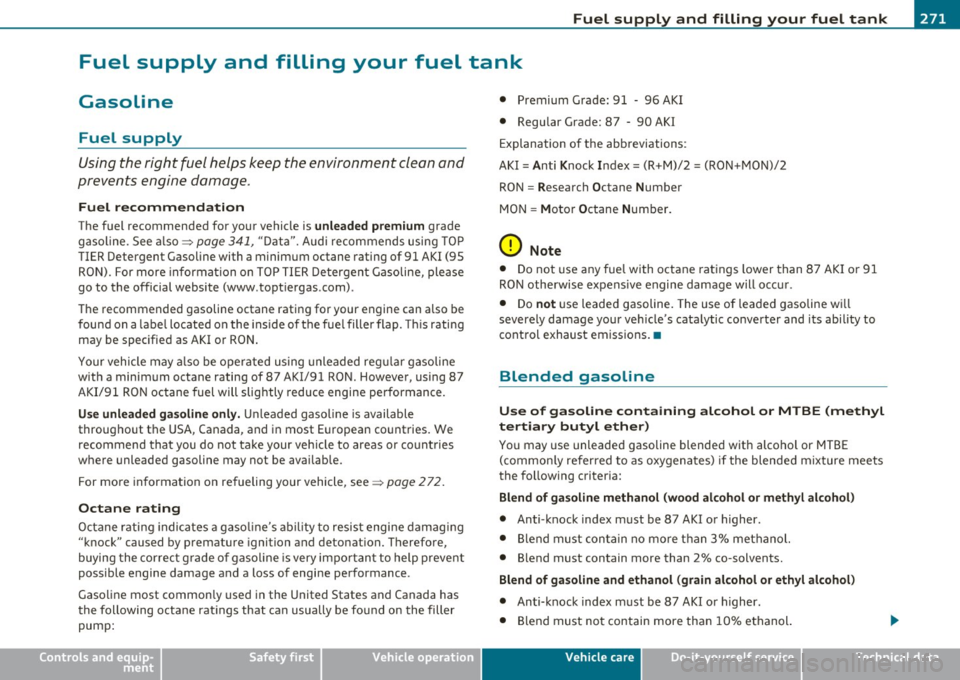
Fuel supply and filling your fuel tank ---------------'--':.......::-----=--=--------
Fuel supply and filling your fuel tank
Gasoline
Fuel supply
Using the right fuel helps keep the environment clean and
prevents engine damage .
Fuel recommendation
The fuel recommended for your vehicle is unleaded premium grade
g asoline . See also :::>
page 341, "D ata ". Aud i recommends using TO P
TIER Detergent Gasoline with a minimum octane ra ting of 91 AKI (95
R O N). For more information on TOP TIE R Detergen t Gasoline, please
go to the official website (www. toptiergas .com) .
Th e recommended gasoline octane rating for your engine can also be
found on a labe l located on the ins ide of t he fue l fille r flap. This rating
may be specified as AKI or RON .
Your vehicle may also be ope rated us ing unleaded reg ular gasoline
with a minim um octane rating of 87 AKI/91 RON. However, us ing 87
AKI/91 RON octane fuel will slig htly reduce engine performance.
Use un leaded ga soline only. U nleaded gaso line is available
throughout the USA, Canada, and in most E uropean co untries. We
recommen d that you do not ta ke your veh icle to areas or co unt ries
where unleaded gasoline may not be available.
F or more in formation on re fueling yo ur vehicle, see:::>
page 272.
Octane rating
Octane r ati ng indi cat es a gaso line's abi lity to resis t engi ne damag ing
"knock" caused by premature ignition and detonat ion. Therefore,
buying the correc t g rade o f gasol ine is very impo rtan t to help preve nt
possible engine damage and a loss of engine performance .
Gaso line most common ly used in the United States and Canada has
the following octa ne rat ings tha t ca n usually be fou nd on the filler
pump :
Safety first
• Premium Grade: 91 - 96 AKI
• Regular Grade: 87 - 90 AKI
Explanation of t he abb reviations :
AKI= Anti Knock Index= (R +M)/2 = (RON+ MON)/2
RO N= Research Octane Number
M ON= M otor Octane Num ber.
0 Note
• Do not use any fue l with octane rat ings lower than 87 AKI o r 91
RO N otherwise expens ive engine damage will occ ur.
• Do
not use leaded gasoline. The use of lea ded gasoline w ill
severely damage your veh icle 's cata lytic converter and its abi lity to
cont rol exhaust emissions .•
Blended gasoline
Use of gasoline containing alcohol or MTBE (methyl
tertiary butyl ether)
Yo u may use unleaded gasoline blended w ith alcoho l or MTBE
( c ommon ly referred to as oxygenates) if the blended mix ture meets
the following criteria:
Blend of ga soline methanol (wood alcohol or methyl alcohol)
• Anti -k nock index m ust be 87 AKI or h igher .
• Bl end must con tain no mo re t han 3% methanol.
• Blend must contain more than 2% co-solvents.
Blend of ga soline and ethanol (grain alcohol or ethyl alcohol)
• Anti-knock index must be 87 AKI o r higher.
• Bl end must no t contain more th an 10% ethanol.
Vehicle care Technical data